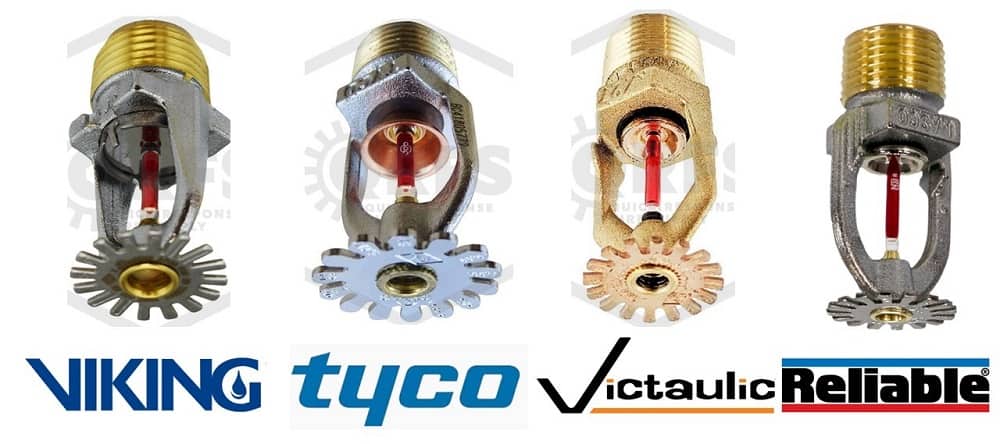A guide to selecting a quick-response, pendent 5.6k fire sprinkler
Choosing a quick response pendent fire sprinkler for a new project can lead to analysis paralysis. There are several options, and all the major brands—Viking, Victaulic, Tyco, Reliable, and Senju—produce quality, reliable sprinkler heads. If they’re all good, how do you choose?
Our Sprinkler Showdown series helps with this decision, comparing fire sprinkler heads with the same essential performance characteristics from different manufacturers. We put them side-by-side so you can see the real differences.
Here, we compare glass-bulb, quick-response pendent sprinklers with 5.6 K-factors: the Viking VK3021, Tyco TY323, Victaulic V2708, and Reliable RA1414. Read on to learn:
- Applications of quick-response sprinklers
- Comparing listings and approvals
- Basic specs, activation temperatures, sprinkler sizes, and threads
- Sprinkler materials
- Available finishes, including those listed for corrosion-resistance
- Accessories, including guards, water shields, and escutcheons
- Summary of main differences
Once you know which sprinkler or accessory you need, find it at QRFS! We have sprinklers, escutcheons, wrenches, and more from Tyco, Reliable, Senju, Victaulic, and Viking.
Applications of quick response sprinklers
As quick response sprinklers, NFPA 13: Standard for the Installation of Sprinkler Systems mandates their use (or other fast response sprinklers) in new light hazard occupancies like banks, hotels, hospitals, and retail establishments. They may also be employed in ordinary hazard occupancies when listed for that use and following the appropriate spacing and discharge density specs.
Quick response heads serve light-hazard occupancies because they prioritize life safety. They go off faster to control fires and give people enough time to escape. However, this isn’t the only benefit.
The NFPA 13 Handbook provides context on the light-hazard requirement in section 9.4.3.1 of NFPA 13: “[E]ven in occupancies where life safety is not the primary reason for sprinkler system installation, such as in offices and restaurants, quick-response sprinklers are still considered important, because they limit fire damage and the potential for injury or death of occupants and fire fighters.”
Now, let’s review the specs, features, and accessories of the VK3021, TY323, V2708, and RA1414:
Comparing listings and approvals
Listings and approvals (aka certifications) show that sprinklers meet vital safety and performance standards—and sprinklers must be listed.
The most important certification indicates a sprinkler meets the performance requirements of UL 199: Standard for Automatic Sprinklers for Fire Protection Service.
While “cULus Listed” and “FM Approval” are the two most prominent approval marks in North America, there are other relevant certifications worldwide, including:
- CE: the European Union
- LCPB: the Loss Prevention Certification Board mark
- VdS: a major test lab in Germany
- UKCA: the UK Conformity Assessed marking for sale in the United Kingdom
- MED: the Maritime Equipment Directive mark, indicting suitability for maritime use
- EAC: a mark for acceptability in the Eurasian Customs Union
- CCC: the China Compulsory Certificate mark for import and sale in China
What sprinklers are listed or approved for can vary at different activation temperatures, maximum working pressures, and applications. For example, a VK3021 (and other models) is UL Listed at a maximum working pressure of 250 PSI (17 bar), whereas FM Approval and a CE state 175 PSI (12 bar). So, make sure to consult the data sheet!
Among the sprinklers we’re comparing, Victaulic’s V2708 has the most approval marks, but all these sprinklers are listed and acceptable to most authorities having jurisdiction:
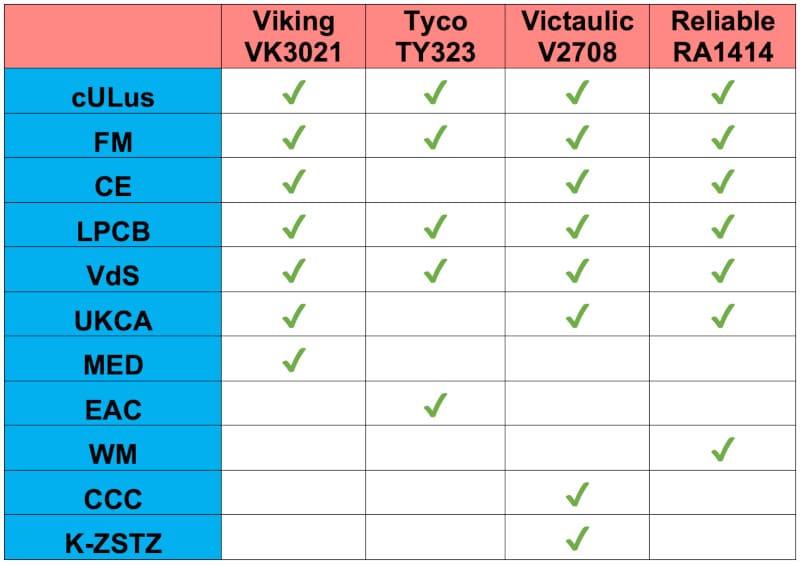
Basic specs, activation temperatures, sprinkler size, and threads: VK3021 vs TY323 vs V2708 vs RA1414
Basic specs
The basic specs for these four sprinklers are the same. Besides being pendent quick-response sprinklers with 5.6 K-factors (80.6 in metric units), they share the same max pressure ratings: 175 PSI (12 bar) approved by FM and 250 PSI (17 bar) listed by UL.
Activation temperatures
They also have identical activation temperatures:
- 135°F (57°C)
- 155°F (68°C)
- 175°F (79°C)
- 200°F (93°C)
- 200°F (93°C)
- 286°F (141°C)
Again, the specific listings and approvals for different temperatures can differ by manufacturer and application—make sure to consult the data sheet.
Sprinkler sizes
There is really only one size difference worth noting: Viking’s VK3021 is the shortest sprinkler on this list, measuring 1 15/16” (49 mm). When you subtract its nominal pipe engagement (also called make-in) of 7/16” (11mm), you end up with a pretty inconspicuous sprinkler, even without a recessed installation.
This sprinkler is part of Viking’s XT1 line, which is specifically designed to be compact and durable (though it comes with a slightly higher price tag). We’ll talk more about XT1 sprinklers in later sections.
Thread sizes—NPT vs BSPT/ISO
All these sprinkler heads have the option of a 1/2” National Pipe Thread (NPT) connection used in North America, South America, and a few other places, and most manufacturers offer models threaded for other international systems.
In much of the world, British Standard Pipe Thread (BSPT) is the preferred connection. BSPT has been adopted internationally and is equivalent to tapered threads complying with ISO 7-R1 standards.
Viking, Victaulic, Reliable, and Tyco offer their sprinklers threaded in BSPT as well as NPT. However, Reliable references the ISO dimension rather than millimeters, and Tyco has the option but does not list it on North American data sheets.

Sprinkler construction materials
To help you choose the best sprinkler for your needs, we’ve compared the materials in their bodies, frames, deflectors, pip caps, springs, and pip cap seals.

Across the VK3021, TY323, V2708, and RA1414, multiple features are the same: they have bronze or brass sprinkler frames, and all use PTFE in the cap seal.
The main difference is in the use of stainless steel. Viking and Tyco have stainless steel pip caps, while Victaulic and Reliable use bronze. Only Viking uses stainless steel in the VK3021 deflector—a feature of their XT1 sprinklers.
Stainless steel is less subject to corrosion than brass or bronze, which could be an advantage in harsh environments. However, UL and FM do not officially recognize sprinklers with stainless steel components as corrosion-resistant—they are not “listed” as such based on it.
Otherwise, here are the slight differences in materials:

Available finishes: VK3021 vs TY323 vs V2708 vs RA1414
Sprinkler finishes serve at least one and perhaps two purposes:
- Providing a pleasing appearance.
Some sprinklers have listed corrosion-resistant finishes that help protect sprinklers from harsh environments.
Here’s a quick summary of the finishes offered by Viking, Tyco, Victaulic, and Reliable:
- All four manufacturers offer brass, chrome, and polyester paint
- Polyester is always cULus listed as a corrosion-resistant finish and is available from the manufacturer in white, black, or custom color
- Viking and Reliable provide an electroless-nickel-Teflon (ENT) corrosion-resistant finish that is cULus Listed and FM Approved.
Victaulic has a proprietary corrosion-resistant finish (cULus and FM) called VC-250.

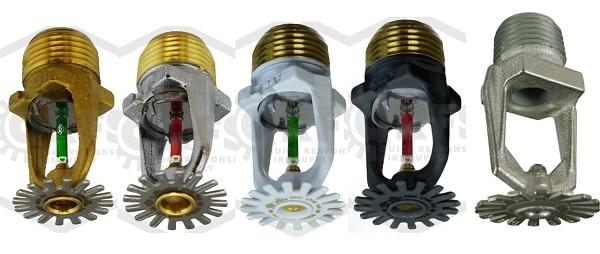
Accessories: escutcheons, water shields, and head guards
Alongside these pendent fire sprinklers, Viking, Victaulic, Tyco, and Reliable produce essential accessories such as escutcheons, water shields, and sprinkler head guards. Here’s what these manufacturers offer for these quick-response, 5.6K heads:
Escutcheons
Escutcheons surround pendent and sidewall sprinklers installed in penetrations through ceilings or walls. These plates provide a clean appearance, covering the gap around the sprinkler and helping hold the head in place. Two-piece, adjustable escutcheons enable a recessed installation into the wall or ceiling.
While escutcheons that protrude from the wall or ceiling don’t require a listing, those for flush or recessed installations do—you must use an escutcheon made by the sprinkler manufacturer. So, when choosing a sprinkler, check the installation type and make sure the available escutcheons have the features you need, including:
- Range of adjustment
- Outer diameter
- Installation style
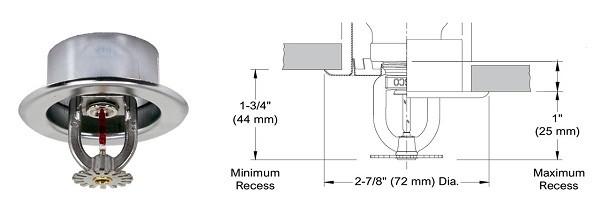
No company is lacking in this area. In terms of options, Viking is somewhat of a standout, as the VK3021 sprinkler is compatible with:
- Escutcheons with the largest adjustment range (Models E2 and E3: 13/16″ (20 mm))
- An oversized escutcheon that can cover the largest gap (Model E3: outer diameter 5-1/8” (130 mm))
- Escutcheons with different connection types (Model E1’s inner cup slips on for installation and adjustment, while the E2 and E3 use threads)
Victaulic and Reliable also have some good points—Reliable’s Model F1 and Victaulic’s V27 escutcheons have a respectable adjustment range of 3/4” (19 mm). Plus, Reliable’s Model FP escutcheon can be installed and adjusted with threads instead of pushing for added stability.
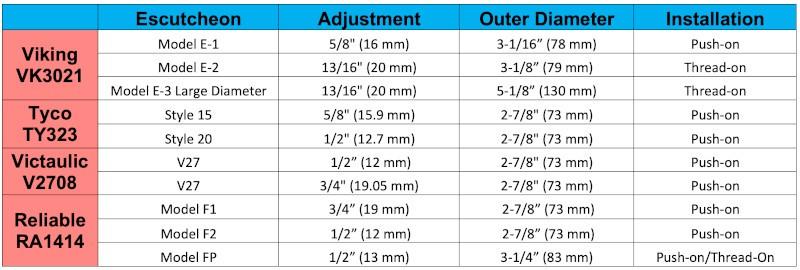
Water shields and head guards
Head guards are protective cages for sprinklers that can prevent damage from collisions. Water shields, commonly found in storage applications, are plates that protect in-rack sprinklers from water sprayed by sprinklers above them, which could cool down the sprinkler and delay activation.
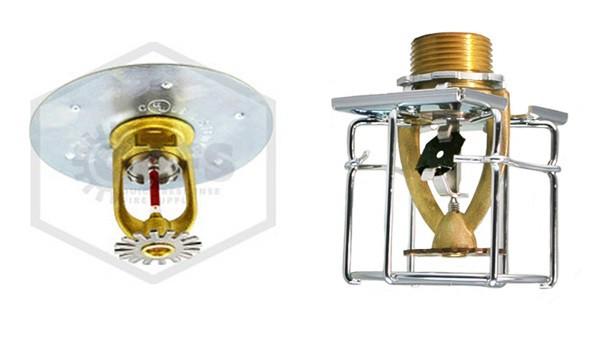
Reliable has an additional option, but the offerings are otherwise similar:
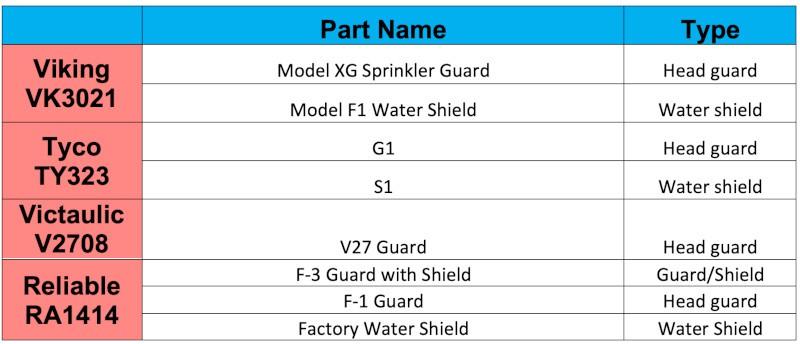
VK3021, TY323, V2708, or RA1414? They’re all great choices (and a summary of differences)
If you’re looking for a quick-response pendent 5.6K sprinkler, you’ve got options—and every one of them is excellent. Viking’s VK3021, Tyco’s TY323, Victaulic’s V2708, and Reliable’s RA1414 all bring quality to the table, as attested by FM, UL, VdS, LPCB, and other certifications.
As discussed above, there are a few differences in certain areas. For example:
- Victaulic has the most approval marks, including one for sale in China
- Viking’s XT1 sprinklers are the most compact
- Viking’s XT1 sprinklers use more stainless steel
- Victaulic has a proprietary corrosion-resistant coating
- Viking and Reliable both have extra-large adjustable escutcheons
However, most of these differences are minor, and the bottom line is that all these sprinklers are great choices.
Shop QRFS’s online inventory of sprinklers, escutcheons, wrenches, and more from Tyco, Reliable, Senju, Victaulic, and Viking. Use the QRFS QuickFinder to ID and order quickly based on the sprinkler identification number (SIN).
If you can’t find what you need on our website, contact us at 888.361.6662 or support@qrfs.com—we’ll help!
This blog was originally posted at blog.qrfs.com. If this article helped you, check us out at Facebook.com/QuickResponseFireSupply or on Twitter @QuickResponseFS.


